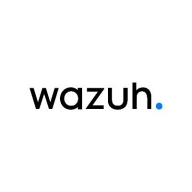

LogRhythm SIEM and Wazuh both compete in the security information and event management (SIEM) space. LogRhythm SIEM seems to have the upper hand due to its advanced intelligence engine, intuitive deployment, and comprehensive reporting and compliance capabilities.
Features: LogRhythm SIEM provides an advanced intelligence engine for real-time monitoring, comprehensive reporting, and compliance features, including PCI and HIPAA. Wazuh is known for its cost-effectiveness, flexibility as an open-source solution, and strong integration capabilities, making it suitable for environments with budget constraints.
Room for Improvement: LogRhythm SIEM needs improvements in file integrity monitoring and better integration with various log sources. Its reporting features can be complex, and integration with ticketing systems like ServiceNow could be improved. Wazuh faces limitations with scalability and real-time detection, particularly on Unix systems. Improvements are needed in threat intelligence and reducing false positives.
Ease of Deployment and Customer Service: LogRhythm SIEM is praised for its ease of deployment across on-premises, cloud, and hybrid environments, along with strong technical support and customer service. Wazuh, also deployable in varied environments, benefits from an active open-source community but lacks dedicated support compared to LogRhythm.
Pricing and ROI: LogRhythm SIEM's premium pricing model suits medium to large organizations, offering significant ROI through enhanced security and operational efficiency despite its higher cost. Wazuh, as an open-source solution, is a low-cost alternative for organizations with limited budgets, though it requires additional resources for configuration and support.
I have seen value in security cost savings with Wazuh, as using proprietary EDR versions could save us substantial money.
The technical support is good; we have a separate portal for partners, and since we are paying for the service, they provide a response timeframe based on severity—critical issues are addressed within four hours, medium issues within one day, and non-urgent issues may take a couple of days.
Customer support is very helpful and effectively solves my problems.
They responded quickly, which was crucial as I was on a time constraint.
We use the open-source version of Wazuh, which does not provide paid support.
The documentation is good and provides clear instructions, though it's targeted at those with technical backgrounds.
LogRhythm SIEM is highly scalable as it has modular components allowing me to expand storage, indexing, or other resources as needed.
LogRhythm SIEM is scalable; it can handle about 200 or 500 devices without much difference.
The scalability of LogRhythm SIEM is good enough, warranting an eight out of ten rating.
It can accommodate thousands of endpoints on one instance, and multiple instances can run for different clients.
Currently, I don't see any limitations in terms of scalability as Wazuh can still connect many endpoints.
Scalability depends on the configuration and the infrastructure resources like compute and memory we allocate.
The platform needs regular updates to fix problems encountered with each quarterly patch and version release.
LogRhythm SIEM still needs improvement regarding stability, particularly in environments with heavy data consumption.
The stability of Wazuh is strong, with no issues stemming from the solution itself.
The stability of Wazuh is largely dependent on maintenance.
The indexer frequently times out, requiring system restarts.
I have noticed some problems with parsing errors, event mismatches, and data mismatching, so ensuring accurate parsing and continuous improvement according to device updates are my basic expectations as a detection engineer.
There is currently no way to determine how much data is being consumed in terms of gigabytes, terabytes, or petabytes from particular devices or environments.
A more user-friendly user interface with drag-and-drop features, similar to key competitors like Splunk, would be beneficial.
Machine learning is needed along with understanding user behavior and behavioral patterns.
The integration modules are insufficiently developed, necessitating the creation of custom integration solutions using tools like Logstash and PubSub.
I think Wazuh should improve by introducing AI functionalities, as it would be beneficial to see AI incorporated in the threat hunting and detection functionalities.
The license cost is around $10 per MPS.
I find LogRhythm SIEM affordable, as it is a bit less costly than QRadar.
Wazuh is completely free of charge.
I would definitely recommend Wazuh, especially considering Fortinet's licensing model which is confusing and overpriced in my opinion.
Totaling around two lakh Indian rupees per month.
The seamless integration for case management, along with a user-friendly dashboard user interface, makes tasks like threat hunting more efficient.
We have enough budget for cloud deployment, but we choose to keep it on-prem to ensure data privacy; cyberattacks are a concern, but data privacy is the foremost priority due to sensitive government information.
This helps SOC analysts significantly as they can monitor all log sources through a dashboard, quickly identifying which sources haven't reported within their specified timeframes.
Wazuh is a SIEM tool that is highly customizable and versatile.
The system allows us to monitor endpoints effectively and collect security data that can be utilized across other platforms such as SOAR.
With this open source tool, organizations can establish their own customized setup.
| Product | Market Share (%) |
|---|---|
| Wazuh | 9.3% |
| LogRhythm SIEM | 2.9% |
| Other | 87.8% |


| Company Size | Count |
|---|---|
| Small Business | 38 |
| Midsize Enterprise | 38 |
| Large Enterprise | 83 |
| Company Size | Count |
|---|---|
| Small Business | 26 |
| Midsize Enterprise | 15 |
| Large Enterprise | 8 |
LogRhythm SIEM Platform is an award-winning platform in security analytics. With more than 4,000 customers globally, LogRhythm SIEM is an integrated platform that helps security operations teams protect critical infrastructure and information from emerging cyberthreats. Ultimately, LogRhythm SIEM is an integrated set of modules that contribute to the security team’s fundamental mission: rapid threat monitoring, threat detection, threat investigation, and threat neutralization. LogRhythm SIEM is for organizations that require an on-premises solution and offers:
● Streamlined workflow
● Secure data access
● Real-time visibility
● A unified user experience
● Management customization
Security information and event management (SIEM) solutions have been evolving for over a decade; their core functionality still acts as the most effective foundation for any organization’s technology stack. A SIEM solution enables an organization to centrally collect data across its entire network environment to gain real-time visibility into activity that may pose a risk to the organization. SIEM technology addresses threats before they become significant financial risks while simultaneously helping better manage an organization’s assets.
LogRhythm SIEM has many key features and capabilities, including:
● High-Performance Log Management: LogRhythm SIEM offers structured and unstructured search capabilities which allows users to swiftly search across an organization’s vast data to easily find answers, identify IT and security issues, and troubleshoot issues. Users can efficiently process and index terabytes of log data daily.
● Network and Endpoint Monitoring: Forensic sensors allow users to gain deep visibility into endpoint and network activity. Users can see behavioral anomalies and better respond to incidents.
● SmartResponse™ Automation: LogRhythm SIEM allows users to centrally execute pre-staged actions that automate incident investigatory tasks and responses.
● Automated Machine Analytics: LogRhythm SIEM's AI Engine continuously analyzes all collected security incidents and forensic data. Security teams are delivered precise, real-time intelligence about risk-prioritized threats.
● Case and Security Incident Management: LogRhythm SIEM offers an integrated workflow so that threats don’t slip through the cracks. Collaboration tools help centrally manage and track investigations.
● User and entity behavior analytics (UEBA): Embedded deterministic UEBA monitoring helps protect against insider threats.
● Security orchestration, automation, and response (SOAR): LogRhythm SIEM includes our embedded SOAR solution to increase efficiency and higher-quality incident response with low mean time to response (MTTR).
Benefits to Using LogRhythm SIEM
● The platform offers great value to security and IT operations. Users have the ability to map their security and IT operations to existing frameworks such as NIST and MITRE ATT&CK.
● The platform offers broad integration across security and IT vendors: Users benefit from support for integration with hundreds of security and IT solutions. In turn, this further extends SIEM capabilities and data collection.
● The platform provides compliance adherence, enforcement, and reporting: The prebuilt compliance modules automatically detect violations as they occur and remove the burden of manually reviewing audit logs.
Reviews from Real Users
LogRhythm SIEM stands out among its competitors for a number of reasons. Two major ones are its ability to be customized and its quick performance of queries.
Jason G., a senior cybersecurity engineer, writes, "I have found the Advanced Intelligence Engine has provided the most value to us because we can customize alarms based on our requirements and have created hundreds of alarms that notify different people for different scenarios."
Andy W., principal consultant at ITSEC Asia, notes, “LogRhythm SIEM covers all our primary security analysis needs. It makes it easier for us to analyze threats and improves our response times. It's a versatile platform that performs queries fast compared to other SIEM solutions.”
Wazuh offers comprehensive security features like MITRE ATT&CK correlation, log monitoring, and cloud-native infrastructure. It ensures compliance and provides intrusion detection with high scalability and open-source flexibility, ideal for businesses seeking robust SIEM capabilities.
Wazuh stands out in security information and event management by providing efficient log aggregation, vulnerability scanning, and event correlation against MITRE ATT&CK. Its capability to integrate seamlessly with environments, manage compliance, and monitor files makes it suitable for cloud-native infrastructures and financial sectors. Despite its technical support needing enhancement and opportunities for improving AI integration and threat intelligence, its open-source nature and cost-effectiveness make it appealing. Users can leverage custom dashboards powered by Elasticsearch for precise data analysis, even though there is a desire for a more user-friendly interface and better enterprise solution integration. Deployment may be complex, but its features contribute significantly to fortified security postures.
What are the essential features of Wazuh?Industries like finance and cloud infrastructure heavily utilize Wazuh for its security strengths. By monitoring endpoints and ensuring compliance with frameworks, companies can improve security posture and swiftly detect anomalies. The platform's focus on event correlation and alerts for security incidents is particularly beneficial.
We monitor all Security Information and Event Management (SIEM) reviews to prevent fraudulent reviews and keep review quality high. We do not post reviews by company employees or direct competitors. We validate each review for authenticity via cross-reference with LinkedIn, and personal follow-up with the reviewer when necessary.